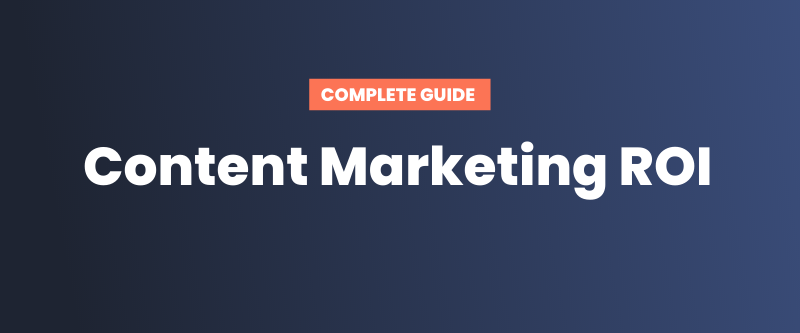Benefits of a Blog Marketing Strategy
Blogging can play an incredible role in an effective content strategy for an SaaS brand. Some of the various benefits include:
- Building a loyal audience
- It can help position you as an authority in your field. Authorities get more sales.
- Blog posts attract more customers.
- Not all SaaS brands have caught on to the effectiveness of blogging, so competition is low.
In order to develop an effective blog marketing strategy, try the following tips.
Develop Your Goals
One of the best strategies with anything you want to do is to be very clear. The more clarity you have, the greater your chance of success.
One of the first steps to take with every single project is to develop very specific goals. Are you aiming to:
- Build buzz around your product?
- Increase your website’s following?
- Collect emails for future launches?
- Increase sales?
- Build your social media presence?
You may have more than one goal, which is perfectly fine, but that often increases the workload. Be sure you are prepared with the necessary tools and manpower.
Most of all, be sure that your goals are clear enough that you know exactly what you are working for.
“Customer Loyalty is mostly about choosing the right customers.” – John Jantsch
Develop Your Target Persona
In order to create an effective content strategy, you need to be clear on whom that content is for. Writing for a recent high school graduate is much different than writing for an experienced business owner.
Start creating your strategy by clearly defining who you wish to target. Try picturing your audience as a singular person and even give him a name.
This is the person you will need to picture for every piece of content you create, so you need to know this ideal target on a personal level. Start by answering the following questions:
- Who is he- or she?
- What does he do for a living?
- Is he a business owner or an employee?
- Is he married?
- Does he have children?
- What are his interests?
- What does he like to do in his free time?
- Is he looking to branch out from his current position or grow his business?
Get to know this ideal person as you would a friend because it is much easier to develop effective content for someone you know than someone you do not. Every time you create content, imagine you are speaking to this one singular person.
“The only way to win at content marketing is for the reader to say, ‘This was written specifically for me’.” – Jamie Turner
Research Your Target
After you know who you are targeting, you need to understand how to target him. You need to learn things such as:
- Where does he hang out online, especially when it comes to social media?
- What does he want to learn?
- What types of questions is he asking?
- What are his struggles and pain points?
There are several ways to learn what you need to know. Once you know what social media platform he hangs out on the most, take a look at the things he posts, shares, and follows. Take note of any questions he asks or complaints he voices.
You can also add polls to those social media platforms and to your website. Your target audience can then answer your questions pertaining to what they are searching for.
Create a Content Plan
A content plan, or an editorial calendar, can make a huge difference in the success of your content or project. The type of content you produce should link directly to your goals, and you need a clear plan to reach those goals.
For instance, let’s say that you are getting ready to launch new software that improves the workflow efficiency of office managers. Though you can just throw it out there when you are ready, this is not usually an effective strategy.
The best way to give your audience members what they want is to ask them what they want, says @BrennerMichael via @CMIContent
Instead, you should prime your audience through a series of content pieces. You might write a series of pieces that address how difficult it is to maintain records, easier ways to create employee schedules, tips for being more productive during the day, and other related topics.
As you draw closer to your launch date, you can start peppering your posts with the solution to these products. By developing and using a content calendar, you can organize these posts so that you provide them in an efficient manner.
An editorial calendar can also save you a lot of time, as you do not have to determine what to post at the last minute. Your content calendar can lay out a month of posts or the whole year, according to your plans and goals.
Keyword Research
Keyword research is another vital component of an effective content strategy. Keywords help you to get in front of the correct audience and let your audience know that they have found the content they need.
The Content Marketing Institute lays out just how important your keywords are:
The keywords you choose truly play an important part of whose results you show up in, and if you show up in any at all.
Search for both short-tail and long-tail keywords. You can easily do this through a keyword research tool such as the Google Keyword Planner. Look for those with low competition but a high amount of searches.
Creating Your Content
Once you have done your planning and your research, it is time to start creating the actual content for your blog. There are certain principles you should follow for the best results.
Helpful Content
No one wants to jump directly into a post about your business or your product. Instead, you should focus on providing helpful and educational.
Share content that your readers can use to make their lives and jobs easier. Directly address the pain points that you discovered during your research.
Consider topics such as:
- 10 Ways to Increase Your Productivity
- How to Create Content People Want to Read
- How I Save 30 Minutes a Day With One Simple Hack
Sharing such content will build loyalty and position you as an authority. When you do present your software, your readers will be more inclined to pay attention.
Beat Your Competition
Before you start writing, check out the competition. Type your keywords into your internet search bar and take a look at the first few results. These are the articles you should work to beat.
Read the content, make note of anything they are missing, and then write those blog posts even better.

Make Content Shareable
You want your readers to share your content, so make it easy for them. Be sure that there are social sharing buttons on each blog post, and ask them to share it.
Also, be sure that the content is something they want to share. You can do this by creating quality, skimmable content with visual elements.
SEO
It does not matter how good your content is if it is not being seen. Use an SEO tool to help you optimize every post.
Also, be sure that you put your keywords to use. Use them in the title, the URL, the body of the text, and the meta description.
End With Clear Call to Action
After you have primed your audience by providing helpful content, you should end each post with a clear call-to-action. These include things like:
- Buy Now
- Download Your Free EBook
- Book a Live Demo
If you do not tell the reader what you want them to do, how can you expect them to do it?
Utilize Email Marketing
Every business should harness the power of email marketing. By collecting emails, you are building a contact list of people that are interested in your product.
“Email has an ability many channels don’t: creating valuable, personal touches- at scale.” – David Newman
Use these email addresses to send out important information, launch announcements, and weekly content to keep your reader hooked.
Opt-In Incentive
It is important to note, though, that a person’s email address is often as sacred as a home address. They do not let you in just because you ask.
Offering an opt-in incentive is the best way to collect email addresses. By offering a demo, a sneak peek, a free report, a how-to guide, or another valuable piece of content, readers are more likely to allow you into their sacred space.
Limit the Number of Emails
Once you have these email addresses, you do not want to lose them. A quick way to do so is to flood the inboxes of your reader.
Limit the number of emails you send. Try not to send more than one a week, except for launch times when you are sending reminders and sales announcements.
Send Helpful Emails
Just like your blog posts, your emails need to provide helpful content. You might simply send out an email with the current week’s blog if you have no additional content to share.
“Use low commitment CTAs. Emails are invites, landing pages are parties.” – Matt Byrd
Preparing for a Product Launch
When gearing up to launch a new product, you will have a little more work to do.
Prelaunch
Do not wait until the actual product launch to start promoting it. As discussed earlier, you should be priming your audience for the big event.
Some successful companies start a pre-launch strategy one to three months prior to the launch date. During this time, they:
- Create a fresh editorial calendar and develop a full launch plan that includes which team member is responsible for each task
- Write blog posts centered around the pain points their software addresses
- Provide “sneak peeks”, demos, or free trial links through blog posts, social media posts, and other platforms
- Offer a pre-launch price to create excitement and urgency
- Build more than one landing page, each of which focuses on a different pain point
- Build their social media presence
- Provide free webinars or podcasts to help build interest and answer questions the audience may have

Launch
During and after the launch, there are a few more steps to take.
1. Provide Easy Onboarding
No one wants to purchase something they do not know how to use. Provide easy onboarding and training videos for anyone who buys your software. You should also include some how-to posts for ways buyers can use your software for the best results.
2. Provide Customer Service
Provide customer service on your website so customers can reach out with any questions. Be available to them as much as possible.
3. Analyze Results
It is imperative to your current and future success to know what is and is not working. Use an analytics tool, such as Google Analytics, to help simplify the process.
Learn which email headlines, blog post titles, and so on get the best results. Keep up the things that are working and tweak those that are not.
Some other important analytics include:
- Pageviews
- Click-through rates from different platforms
- Social shares
- Time on website
- Backlinks
- Engagement
- Traffic
Paying attention to these results and putting them to use will propel your brand even further.
Blog marketing can play a vital role in the success of your SaaS brand and your product launches. By utilizing blog marketing, you can gain your target audience’s trust and gain customers you might not reach otherwise.





